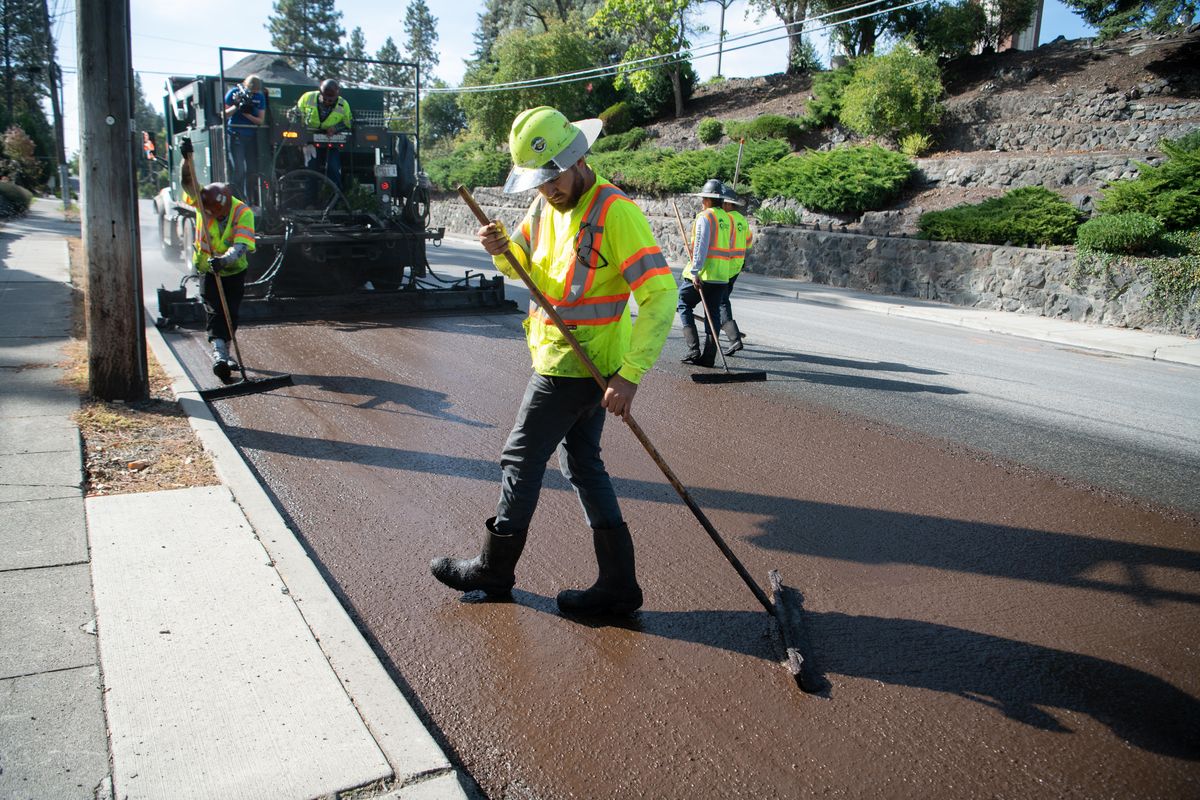Spokane tries new road preservation technique ‘to keep the good streets good for longer’

The city of Spokane is trying a new road preservation technique in a bid to prevent streets from developing cracks that eventually turn into potholes for cars to rattle and bounce through.
So far this year the city has used the technique, called a micro overlay, on three stretches of road, including Washington Street from Buckeye to Indiana and Wall Street from Wellesley to Francis. The final section, Bernard Street from 14th to 29th avenues, was completed Saturday.
In a micro overlay, a special machine is used to spread a thin layer of a wet slurry made from the combination of aggregate, emulsified asphalt and a polymer over the road from curb to curb, said Clint Harris, the city’s director of street maintenance. “It’s very similar to a chip seal, but it uses a finer aggregate so it will create a nicer surface for the bike folk,” he said.
The sections of street picked for the micro overlay were not in bad condition but were developing micro cracks, Harris said.
“The intent is to seal the road,” he said. “The water is the enemy. That’s the intent of maintenance, to keep the good streets good for longer.”
Once a road develops cracks, water seeps in. When that water freezes in the winter, the cracks widen and potholes develop. During times of rapid freeze-thaw cycles, large potholes can seem to appear overnight. Sealing streets to keep the water out means the roadbed stays dry and potholes don’t develop, Harris said.
The section of Bernard treated on Saturday is about 10 to 12 years old. Harris said the overlay should extend its life another five to seven years before more drastic and expensive maintenance is needed, such as a grinding down of the existing road and replacing it with a new asphalt surface.
Doing the overlay on the three street sections is a pilot project to see if the method is effective, Harris said. “Were evaluating how it holds up for the winter time,” he said. “This is not a new process, but it’s new to our region. There are no contractors in this area who do it.”
The city hired Intermountain Slurry Seal from Reno, Nevada, to do four miles of street for $200,000. Spokane County also hired the same contractor to do two miles of road, Harris said. The two contracts were enough to entice the contractor to travel here to do the work, Harris said.
The slurry is a dark brown color when it is first applied but darkens as it dries. The micro overlay process is relatively quick. Harris estimated it would take crews only three hours to complete the stretch of Bernard between 14th and 29th avenues and then the slurry needs four hours to dry before it can be driven on. He expected the road to reopen early Saturday evening.
“So far we’ve had really good success and are pleased with how it turned out,” he said.
The only hitch has been the wet weather. The process cannot be done in the rain, and the work on Bernard was originally scheduled for earlier in the week. “We had been trying to plan around the weather, which is very hard,” he said.
Harris said he hopes to add the micro overlay process to his list of street preservation options. Currently, the city can do crack sealing, chip sealing, a grind and overlay, or full replacement of a road, depending on its condition.
“The cost escalates on each one,” he said. “We’re always looking for new ideas, new ways to preserve the pavement.”
The micro overlay treatment is ideal for streets that are just starting to show signs of deterioration. “This wouldn’t work on a really bad street with big cracks in it,” Harris said.
Once the slurry dries, the city will have to go back and restripe the street, Harris said. They plan to add northbound and southbound bike lanes when they do so, he said.